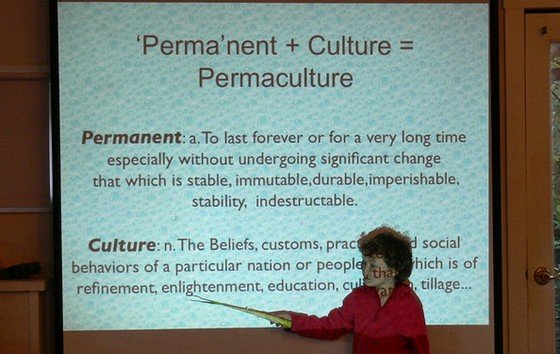What Is Permaculture?
How Does Permaculture Work?
Definitions, Explanations, Examples
What is permaculture? How does permaculture work? If I had a dollar for every time I answered that question I'd be a very happy permaculturist indeed...
To be honest, to me permaculture is mainly a way to have an organic food garden that's stunningly beautiful, productive, and comes without any tedious garden work...
"Permaculture has, in many people's minds, come to represent a sustainable, organic, home vegetable garden." (Rosemary Morrow)
...but that is only one aspect of permaculture. Of course there is a lot more to it.
There are some official explanations and definitions that answer the question "What Is Permaculture?", but in my experience they still leave people confused. I'll try to explain it a bit more.
I'll start with the history and the official explanations, then I'll translate it into something that makes sense to the average home gardener and suburbanite.
After that intro you best follow the links at the bottom, which will take you to some specific examples. That should make some light bulbs come on and everything should fall into place.
"You can fix all the world's problems, in a garden. You can solve them all in a garden. You can solve all your pollution problems, and all your supply line needs in a garden. And most people today actually don't know that, and that makes most people very insecure." (Geoff Lawton)
What Is Permaculture? - Definitions
The term permaculture combines the words permanent and culture, or permanent and agriculture, and that is the first hint to what it's all about.
 The definition of Permaculture. Photo: planet a
The definition of Permaculture. Photo: planet a
The philosophy behind permaculture was developed about thirty years ago in Australia by Bill Mollison and David Holmgren.
During his many years as a wildlife biologist Bill Mollison had witnessed first hand the destruction that humans are causing in natural systems, but he also had a chance to observe how these natural ecosystems work and what keeps them in balance.
Permaculture design is a result of these observations.
Bill Mollison and his then student David Holmgren first published their ideas in 1978, in a book called Permaculture One, introducing a "design system for creating sustainable human environments", based on close observation of natural systems.
In a later book, Introduction to Permaculture, Bill Mollison writes:
"The aim is to create systems that are ecologically-sound and economically viable, which provide for their own needs, do not exploit or pollute, and are therefore sustainable in the long term."
"Permaculture uses the inherent qualities of plants and animals combined with the natural characteristics of landscapes and structures to produce a life-supporting system for city and country, using the smallest practical area."
Now that's a mouthful. What the heck does it mean?
What Is Permaculture? - Let Me Try To Explain...
What Bill Mollison describes in his books is a totally integrated design system that's modelled on nature. If you design your garden or farm like a natural system, then you can save yourself a lot of work, save energy, and eliminate waste.
Think about it: nobody digs and sows, plants and weeds, or sprays bugs in a forest. Still, all those chores are taken care of somehow. The forest grows and feeds its inhabitants, doesn't it?
If any task in your garden is an unpleasant chore then there is definitely a better way to do it or to eliminate it. Learn from nature. Nature has already developed a solution to every problem that you could possibly encounter in your garden.
Nature is also the ultimate recycler. Everything goes round and round. There is no such thing as "waste". Everything is a resource.
And most importantly, it's sustainable. It's something that works in the long run, not something that is based on inputs that will eventually run out, not something that creates waste and problems that will eventually upset the system.
Design is the keyword. It's all about how you place the design elements together. Look at how things work together in nature, and then try and mimic that design in your garden.
You can find plenty of specific examples for this under Permaculture Design Principles, and once you grasped how it works it's easy to apply on a small scale.
The beauty of it is that permaculture principles work everywhere, in every climate and on every scale. They can be applied to whole villages or housing estates (though it takes a deeper understanding and more planning to do that), or to a tiny backyard or balcony (which can be done very easily).
If you think ahead and design your permaculture garden right, it won't take much effort, it will mostly look after itself, and it will also be incredibly productive and beautiful and attractive to wildlife.
Permaculture is about "...saving the planet and living to be a hundred, while throwing very impressive dinner parties and organising other creatures to do most of the work." (Linda Woodrow)
For the big picture view of the permaculture philosophy read Permaculture Principles.
To skip the big words and visions and get straight to the meat of it, to the design of your garden, read about the Permaculture Design Guidelines.